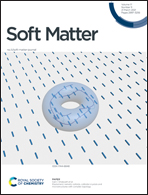Anisotropic swelling of anisotropic elastic panels
Abstract
While isotropic in-plane swelling problems for thin elastic sheets have been studied extensively in recent years, many shape-programmable materials, including nematic solids and 3D-printed structures, are anisotropic, as are most industrial sheet materials. In this theoretical work, we consider central swelling and shrinkage of plates of aspect ratio and material properties relevant to the manufacture of engineered wood composite panels in which both in-plane swelling and material stiffness are highly orthotropic, leading to multiple separations in energy scales. With transverse swelling in the soft direction, and gradients in the stiff direction, the warped plates adopt two distinct types of configurations, axisymmetric and twisted, which we illustrate with toy models. We employ a two-parameter family of isometries to embed the metric programmed by the swelling, thus reducing the problem to one of minimizing bending energy alone. A simple argument is seen to closely predict averaged axisymmetric curvatures. While purely cylindrical shapes are unobtainable by pure in-plane swelling, they can be closely approximated in a highly anisotropic system. However, anisotropy can favor twisting, and breaks a degenerate soft deformation mode associated with minimal surfaces in isotropic materials. Bifurcations from axisymmetric to twisted shapes can be induced by anisotropy or by certain attributes of a central shrinkage profile. Finally, we note how our findings indicate practical limitations on the diagnosis of moisture inhomogeneities in manufactured panels by observation of warped conformations, due to the sensitivity of the qualitative response to specifics of the profile.



 Please wait while we load your content...
Please wait while we load your content...